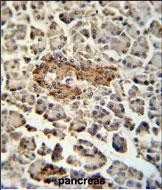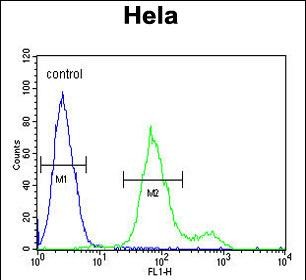SUMF1 Antibody (C-Term)
Affinity Purified Rabbit Polyclonal Antibody (Pab)
- SPECIFICATION
- CITATIONS
- PROTOCOLS
- BACKGROUND

Application
| FC, IHC-P, WB, E |
|---|---|
| Primary Accession | Q8NBK3 |
| Other Accession | Q0P5L5 |
| Reactivity | Human |
| Predicted | Bovine |
| Host | Rabbit |
| Clonality | Polyclonal |
| Isotype | Rabbit IgG |
| Calculated MW | 40556 Da |
| Antigen Region | 303-331 aa |
| Gene ID | 285362 |
|---|---|
| Other Names | Sulfatase-modifying factor 1, 1899-, C-alpha-formylglycine-generating enzyme 1, SUMF1, FGE |
| Target/Specificity | This SUMF1 antibody is generated from rabbits immunized with a KLH conjugated synthetic peptide between 303-331 amino acids from the C-terminal region of human SUMF1. |
| Dilution | FC~~1:10~50 IHC-P~~1:50~100 WB~~1:1000 E~~Use at an assay dependent concentration. |
| Format | Purified polyclonal antibody supplied in PBS with 0.09% (W/V) sodium azide. This antibody is purified through a protein A column, followed by peptide affinity purification. |
| Storage | Maintain refrigerated at 2-8°C for up to 2 weeks. For long term storage store at -20°C in small aliquots to prevent freeze-thaw cycles. |
| Precautions | SUMF1 Antibody (C-Term) is for research use only and not for use in diagnostic or therapeutic procedures. |
| Name | SUMF1 {ECO:0000303|PubMed:12757706, ECO:0000312|HGNC:HGNC:20376} |
|---|---|
| Function | Oxidase that catalyzes the conversion of cysteine to 3- oxoalanine on target proteins, using molecular oxygen and an unidentified reducing agent (PubMed:12757706, PubMed:15657036, PubMed:15907468, PubMed:16368756, PubMed:21224894, PubMed:25931126). 3- oxoalanine modification, which is also named formylglycine (fGly), occurs in the maturation of arylsulfatases and some alkaline phosphatases that use the hydrated form of 3-oxoalanine as a catalytic nucleophile (PubMed:12757706, PubMed:15657036, PubMed:15907468, PubMed:16368756, PubMed:25931126). Known substrates include GALNS, ARSA, STS and ARSE (PubMed:12757706, PubMed:15657036, PubMed:15907468). |
| Cellular Location | Endoplasmic reticulum lumen |
| Tissue Location | Ubiquitous. Highly expressed in kidney, pancreas and liver. Detected at lower levels in leukocytes, lung, placenta, small intestine, skeletal muscle and heart |

Thousands of laboratories across the world have published research that depended on the performance of antibodies from Abcepta to advance their research. Check out links to articles that cite our products in major peer-reviewed journals, organized by research category.
info@abcepta.com, and receive a free "I Love Antibodies" mug.
Provided below are standard protocols that you may find useful for product applications.
Background
SUMF1 encodes an enzyme that catalyzes the hydrolysis of sulfate esters by oxidizing a cysteine residue in the substrate sulfatase to an active site 3-oxoalanine residue, which is also known as C-alpha-formylglycine.
References
Oshikawa, M., et al. Mol. Vis. 15, 482-494 (2009)
Fraldi, A., et al. Hum. Mol. Genet. 17(17):2610-2621(2008)
Hara, K., et al. Neurology 71(8):547-551(2008)
Yis, U., et al. Brain Dev. 30(5):374-377(2008)
If you have used an Abcepta product and would like to share how it has performed, please click on the "Submit Review" button and provide the requested information. Our staff will examine and post your review and contact you if needed.
If you have any additional inquiries please email technical services at tech@abcepta.com.













 Foundational characteristics of cancer include proliferation, angiogenesis, migration, evasion of apoptosis, and cellular immortality. Find key markers for these cellular processes and antibodies to detect them.
Foundational characteristics of cancer include proliferation, angiogenesis, migration, evasion of apoptosis, and cellular immortality. Find key markers for these cellular processes and antibodies to detect them. The SUMOplot™ Analysis Program predicts and scores sumoylation sites in your protein. SUMOylation is a post-translational modification involved in various cellular processes, such as nuclear-cytosolic transport, transcriptional regulation, apoptosis, protein stability, response to stress, and progression through the cell cycle.
The SUMOplot™ Analysis Program predicts and scores sumoylation sites in your protein. SUMOylation is a post-translational modification involved in various cellular processes, such as nuclear-cytosolic transport, transcriptional regulation, apoptosis, protein stability, response to stress, and progression through the cell cycle. The Autophagy Receptor Motif Plotter predicts and scores autophagy receptor binding sites in your protein. Identifying proteins connected to this pathway is critical to understanding the role of autophagy in physiological as well as pathological processes such as development, differentiation, neurodegenerative diseases, stress, infection, and cancer.
The Autophagy Receptor Motif Plotter predicts and scores autophagy receptor binding sites in your protein. Identifying proteins connected to this pathway is critical to understanding the role of autophagy in physiological as well as pathological processes such as development, differentiation, neurodegenerative diseases, stress, infection, and cancer.




